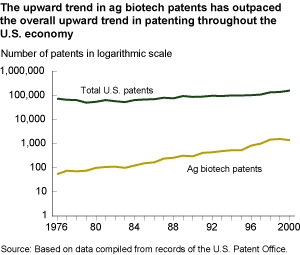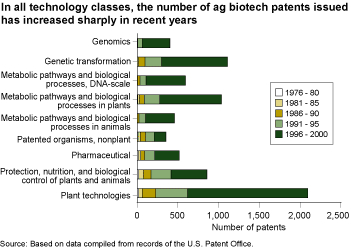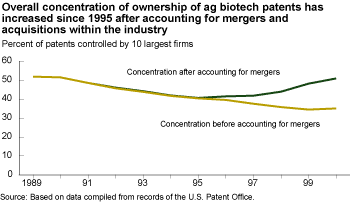Ag Biotech Patents: Who Is Doing What?
- by John King and Paul Heisey
- 11/1/2003
Patents—which give inventors of new technology exclusive rights to make, use, or sell a discovery for a specific period of time—have been used in the U.S. since 1790, and have often served as a stimulus to progress. For example, the cotton gin (1793) greatly increased the profitability of southern cotton, and barbed wire (1868) provided inexpensive fencing material for a rapidly settling frontier. Today, patents and other intellectual property demarcate ownership claims on the expanding frontier of ag biotech research. Patents cover applications of new scientific techniques to traditional agricultural pursuits, as well as innovations in plant and animal breeding, crop inputs (pesticides, fertilizer, etc.), food-processing techniques, and many other aspects of agricultural production.
Upward trend in ag biotech
The upward trend in ag biotech patents has outpaced the overall upward trend in patenting throughout the U.S. economy. This trend reflects increased research and development, changing legal doctrine on what can be patented, and different strategic uses of intellectual property protection.
New computerized database
To better analyze and understand the economic effects of the trend, ERS researchers and academic collaborators have assembled comprehensive data on ag biotech patents and other intellectual property. The data are currently being formatted into a new computerized database, which is expected to be online and searchable in the near future. The database classifies a wide range of technologies used in agriculture, particularly innovations derived from plant molecular biology. The database also includes information on commercial ownership and public sector interest in several forms of intellectual property.
With the range of information included—technology classification, ownership, intellectual property rights, and other aspects—this resource will support research not only on ag biotech patents, but also on related areas, such as research and development spending, innovation, and productivity.
Technology classification
To differentiate the wide range of innovations in ag biotech, the database classifies each biotech patent by scientific, agronomic, and economic attributes. Many patents are classified into several categories. A patent might be classified under “genomics” because it covers identification of a beneficial plant genetic trait with genomic sequencing of its DNA; under “genetic transformation” because it describes the incorporation of a trait into a plant; and under “protection, nutrition, and biological control of plants and animals” because the transformed plant expresses an improved agronomic property such as higher yield, pest resistance, drought tolerance, etc. Other patents cover research on “metabolic pathways,” which are series of naturally occurring chemical reactions that regulate an organism's biological functions. Also some patents may be classified under “pharmaceuticals” because the ag biotech products have livestock or human applications. Many human pharmaceuticals, such as insulin, may include an agricultural aspect in that they are produced using plant or animal cell cultures.
Patent ownership types
The database also groups patents into entity types (firms, non-profits, Federal government, etc.) to facilitate analysis of patenting behavior across these different sectors. Most U.S. ag biotech patents are issued to commercial firms, but universities, state agricultural experiment stations, and the federal government also file patents on inventions. Commercial firms file patents to establish market share, earn royalties, and in some cases block competitors from using new technologies. Universities, nonprofit institutions, and public-sector research entities often use patents and licensing as technology transfer mechanisms.
Ownership concentration
The database also includes changes in patent ownership resulting from mergers, acquisitions and divestitures in the ag biotech industry from 1988-2000. While firms merge for various reasons, the database allows researchers to analyze resulting changes in patterns of intellectual property ownership and the economic aspects of firm combinations. For example, mergers typically result in increased concentration of patent ownership. Taking into account firm acquisitions and splits, the top ten patent assignees controlled over half of ag biotech patents issued through 2000. If acquisitions were not taken into account, the top ten patent assignees as designated on the original patents would have controlled only about one-third of the ag biotech patents.
You may also like:
- Agricultural Biotechnology Intellectual Property. (2004). USDA, Economic Research Service.





